There are several stories of healing in the New Testament in which Jesus tells the paralytic in question to “take up his mat.” The specifics differ from Gospel to Gospel, but the mat element stays the same. I’ve heard various interpretations of just why Jesus asks the one healed to take his mat, this symbol of his former life with him. Perhaps he must take up his mat so others will be able to identify him, or as proof of his healing. Maybe Jesus asks the man to take his mat with him as a way to stick it to the Pharisees who are horrified by a healing on the Sabbath. There are as many interpretations as there are readers.
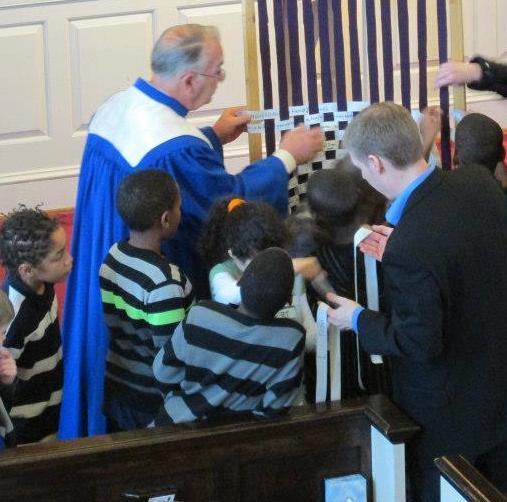
My own interpretation of “take up your mat” came to me when Todd was in seminary and we were attending a Bible study on the book of John. I had both the scripture and a little bit of my master’s thesis on the post-war suffering of Vietnam veterans, rattling around in my head. Specifically, the support community that has developed among veterans in the face of that suffering. And as we pulled into the church parking lot, it occurred to me that the reason Jesus asks the healed man to take up his mat, was so that he could then use that mat to carry others to Jesus.
“the reason Jesus asks the healed man to take up his mat, was so that he could then use that mat to carry others to Jesus.”
Our healing, our answered prayers, our thanksgivings, our accomplishments, these testimonies are not for us alone. As it says in John 11:4 about the healing of Lazarus, it was all for “God’s glory and so that the Son of God might be glorified through it” and repeats this phrase two chapters later after Christ washes his disciple’s feet and gives them the command to love one another. Serving, loving and glorifying are all woven together in this gospel.
It was a few years later at our church in Maryland when I thought of a way to represent this interpretation of “take up your mat” in a project I called, “Weaving Our Testimonies Together.” For this project, the congregation will create together in the worship service a “mat” of woven testimonies. Although the interpretation came to me when studying John, this activity can be used with other scripture passages. Our Maryland church actually did this activity during Lent in conjunction with Todd’s sermon on the “Four Friends”, while we created our woven mat during the fall at our church in Toronto.
Here are some instances in the New Testament of a healing with the accompanying command, “take up your mat” :
Matthew 9:1-8, Mark 2:1-12, Luke 5:17-26, John 5:1-18
Any of them would work as a companion text for this project.
I was fortunate to have talented church members each time to build a nice frame for our weavings, but any simple wooden frame would do. I have seen large stretcher bars in art supply stores that would work or wooden molding from the hardware store, even long branches could serve as a rustic looking mat frame. Depending on the size of your congregation, it might be necessary to create two mats. This has the advantage of moving the weaving process along more quickly if you have a limited amount of time in the worship service.
In weaving there is the warp, the long stationary strips attached to the frame, purple in these photographs, and the weft. The weft is the yarn, or fabric in this case, that you weave in and out between the warp. In these photographs the weft is white.
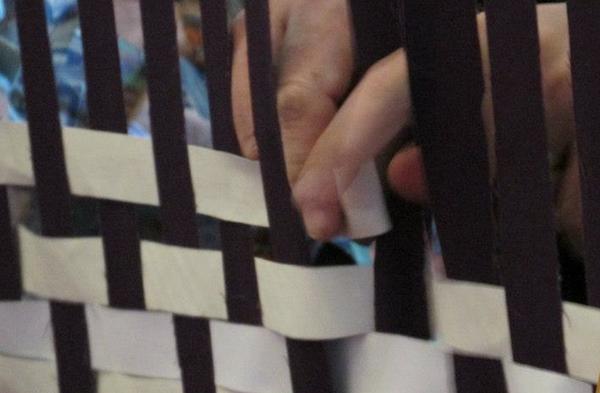
The material for the warp can be whatever color you like. I went with purple to coordinate with the liturgical season. I would suggest making sure that it’s a material that isn’t going to fray a great deal when cut, but other than that precaution, I don’t have any specific suggestions. I found a purple sheet at the thrift store in Toronto that worked just as well as the material I purchased in Maryland from the fabric store. Cut this fabric into long strips. The length of your frame plus another six inches on each end should more than be enough. Those extra inches you will pull over and under the top and bottom edges of the frame and staple with a staple gun on the back of the frame. Make sure it’s taught, but not so tight that you can’t manipulate the weft. Trim any extra fabric that hangs past the staple.
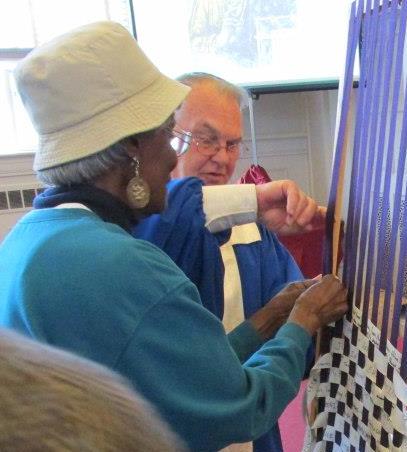
For the weft, I am particular about fabric. The best thing that I have found for this project is black-out curtain material. You can find this material at some fabric stores. Often it’s with the curtain and decorator material on large rollers. Another option, which I did in Canada where fabric stores are few, is to buy black-out curtains online and cut them up. Sometimes these are also listed as black-out curtain liners. It is called “black-out” material because it is opaque, and you can buy this fabric or liners in black or white. You want the white. Black out curtain material is ideal because it has a nice smooth side to write on. The back of the fabric is slightly rougher, so make sure to specify to members to use the smooth side. A few will still be confused, but in the finished weaving, you can’t really tell the difference so it isn’t a big deal.
Cut the black-out liners or material into strips a few inches longer than the width of your weaving frame. Try a test strip before you cut the rest to make sure it’s long enough once it is actually woven over and under the weft because that process will use up a bit of the length. You also want enough length to have at least an inch hanging over the edge for creating a hem on the finished mat if you plan on displaying it.
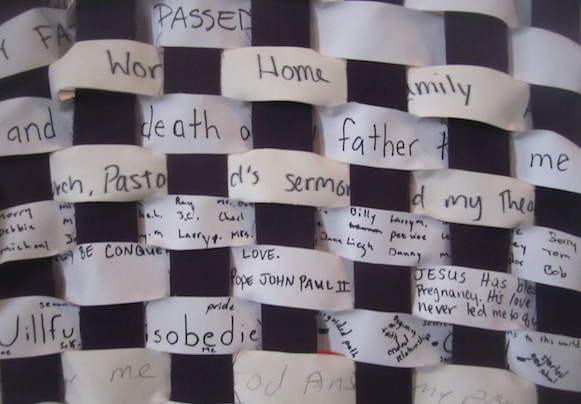
Distribute fine lined permanent markers like Sharpies to the congregation, leave them on the pews, pass them out or have designated tables for writing. The strips of white black-out material could be handed out with church bulletins before the service, or passed down the pews during.
Then, at a time set aside in the worship service, ask participants to think about an event or a time in their lives when God answered a prayer or helped them through a difficult situation and how God might use that experience to help others. Ask members to then write down this testimony, or a praise or thanksgiving associated with it on the smooth side of the white strip of fabric they received. This can be as many or as few words as they feel necessary. No one will be reading it and once it’s woven into the mat, it will be even more difficult to decipher. I have even had children just draw pictures of things they are thankful for and adults can do this too.
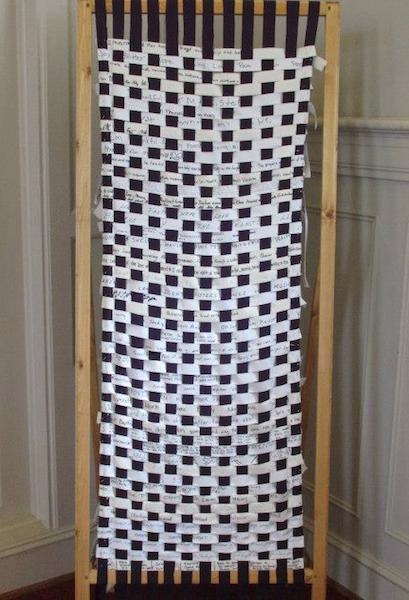
For our time of “Weaving Our Testimonies Together” we played music and lined up in the aisles and members took turns weaving their written strips into the mat. It was useful to have a few people stationed at the weaving frames to assist congregants. I would also suggest weaving a few blank strips into the warp before hand to create a base for the congregation’s testimony strips to come. Having this blank border of strips at the bottom also provides a hem for the finished mat.
In Maryland the finished weaving became part of our worship space. While in Toronto, I turned our mats into banners to decorate the sanctuary during Lent.
We have done this collaborative art project at worship services in two different churches, and I think those who participated in weaving the mats found it meaningful. Many worship service focus on the salvation of the individual and God’s redeeming work, but say little about our response and responsibility. I think it is helpful to find a hands on way like this weaving to both reflect on what God has done for us, and then turn that around into something we can do for others. And creating a collaborative piece reminds the church that we are a Body together. All of our individual experiences with God can combine to create something much greater and more transformative. May we take up our mats in love and service for God’s glory and so that the Son of God might indeed be glorified.





























